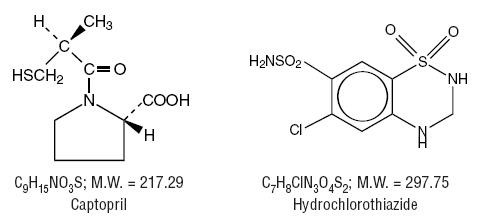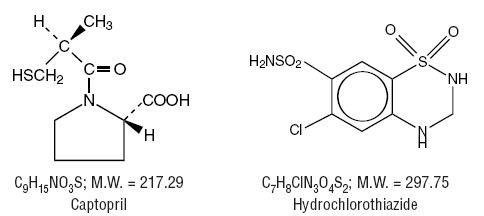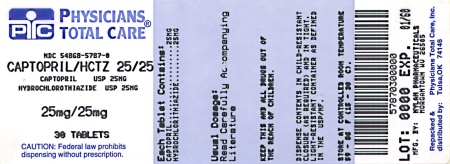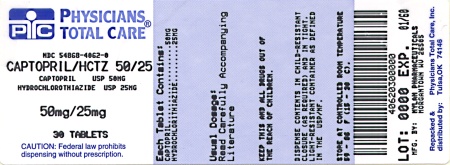Captopril and Hydrochlorothiazide (captopril 50 mg hydrochlorothiazide 25 mg) Dailymed
Generic: captopril and hydrochlorothiazide is used for the treatment of Angioedema Arthritis, Rheumatoid Bartter Syndrome Diabetic Nephropathies Edema Heart Failure Hyperaldosteronism Hypertension, Malignant Hypotension Pregnancy Raynaud Disease Hypertrophy, Left Ventricular Ventricular Dysfunction, Left Anuria Hypertension Nephrotic Syndrome Renal Insufficiency
IMPRINT: M 86
SHAPE: oval
COLOR: orange
All Imprints
captopril 50 mghydrochlorothiazide 25 mg - m 86 oval orange
captopril 25 mghydrochlorothiazide 25 mg - m 83 round orange
captopril 25 mghydrochlorothiazide 15 mg - m 81 round white
captopril 50 mghydrochlorothiazide 15 mg - m 84 oval white
Boxed Warning
Boxed Warning Section
Go PRO for all pill images
Rx only
Boxed Warning Section
USE IN PREGNANCY
When used in pregnancy during the second and third trimesters, ACE Inhibitors can cause injury and even death to the developing fetus. When pregnancy is detected, Captopril and Hydrochlorothiazide should be discontinued as soon as possible. SeeWARNINGS: Captopril: Fetal/Neonatal Morbidity and Mortality .
Description
Captopril and hydrochlorothiazide tablets, USP for oral administration combines two antihypertensive agents: captopril and hydrochlorothiazide. Catopril, the first of a new class of antihypertensive agents, is a specific competitive inhibitor of angiotensin I-converting enzyme (ACE), the enzyme responsible for the conversion of angiotensin I to angiotensin II. Hydrochlorothiazide is a benzothiadiazide (thiazide) diuretic-antihypertensive.
Captopril, USP is a white to off-white crystalline powder that may have a slight sulfurous odor; it is soluble in water (approx. 160 mg/mL), methanol, and ethanol and sparingly soluble in chloroform and ethyl acetate.
Hydrochlorothiazide, USP is a white crystalline powder slightly soluble in water but freely soluble in sodium hydroxide solution.
Captopril is designated chemically as 1-[(2S)-3-Mercapto-2-methylpropionyl]-L-proline; Hydrochlorothiazide is 6-Chloro-3,4-dihydro-2H-1,2,4-benzothiadiazine-7-sulfonamide 1,1-dioxide. Their structural formulas are:


Captopril and Hydrochlorothiazide Tablets, USP are available for oral administration in four combinations of captopril with hydrochlorothiazide: 25 mg with 15 mg, 25 mg with 25 mg, 50 mg with 15 mg, and 50 mg with 25 mg. In addition, each tablet contains the following inactive ingredients: anhydrous lactose, colloidal silicon dioxide, croscarmellose sodium, magnesium stearate, microcrystalline cellulose, pregelatinized starch, and sodium lauryl sulfate. The 25 mg/25 mg and 50 mg/25 mg tablets also contain the coloring agent FD&C Yellow #6 Aluminum Lake.
Clinical Pharmacology
Captopril Mechanism of Action
The mechanism of action of captopril has not yet been fully elucidated. Its beneficial effects in hypertension and heart failure appear to result primarily from suppression of the renin-angiotensin-aldosterone system. However, there is no consistent correlation between renin levels and response to the drug. Renin, an enzyme synthesized by the kidneys, is released into the circulation where it acts on a plasma globulin substrate to produce angiotensin I, a relatively inactive decapeptide. Angiotensin I is then converted by angiotensin converting enzyme (ACE) to angiotensin II, a potent endogenous vasoconstrictor substance. Angiotensin II also stimulates aldosterone secretion from the adrenal cortex, thereby contributing to sodium and fluid retention.
Captopril prevents the conversion of angiotensin I to angiotensin II by inhibition of ACE, a peptidyldipeptide carboxy hydrolase. This inhibition has been demonstrated in both healthy human subjects and in animals by showing that the elevation of blood pressure caused by exogenously administered angiotensin I was attenuated or abolished by captopril. In animal studies, captopril did not alter the pressor responses to a number of other agents, including angiotensin II and norepinephrine, indicating specificity of action.
ACE is identical to "bradykininase", and captopril may also interfere with the degradation of the vasodepressor peptide, bradykinin. Increased concentrations of bradykinin or prostaglandin E2 may also have a role in the therapeutic effect of captopril.
Inhibition of ACE results in decreased plasma angiotensin II and increased plasma renin activity (PRA), the latter resulting from loss of negative feedback on renin release caused by reduction in angiotensin II. The reduction of angiotensin II leads to decreased aldosterone secretion, and, as a result, small increases in serum potassium may occur along with sodium and fluid loss.
The antihypertensive effects persist for a longer period of time than does demonstrable inhibition of circulating ACE. It is not known whether the ACE present in vascular endothelium is inhibited longer than the ACE in circulating blood.
Pharmacokinetics
After oral administration of therapeutic doses of captopril, rapid absorption occurs with peak blood levels at about one hour. The presence of food in the gastrointestinal tract reduces absorption by about 30 to 40 percent; captopril therefore should be given one hour before meals. Based on carbon-14 labeling, average minimal absorption is approximately 75 percent. In a 24-hour period, over 95 percent of the absorbed dose is eliminated in the urine; 40 to 50 percent is unchanged drug; most of the remainder is the disulfide dimer of captopril and captopril-cysteine disulfide.
Approximately 25 to 30 percent of the circulating drug is bound to plasma proteins. The apparent elimination half-life for total radioactivity in blood is probably less than three hours. An accurate determination of half-life of unchanged captopril is not, at present, possible, but it is probably less than two hours. In patients with renal impairment, however, retention of captopril occurs (see DOSAGE AND ADMINISTRATION).
Pharmacodynamics
Administration of captopril results in a reduction of peripheral arterial resistance in hypertensive patients with either no change, or an increase, in cardiac output. There is an increase in renal blood flow following administration of captopril and glomerular filtration rate is usually unchanged. In patients with heart failure, significantly decreased peripheral (systemic vascular) resistance and blood pressure (afterload), reduced pulmonary capillary wedge pressure (preload) and pulmonary vascular resistance, increased cardiac output, and increased exercise tolerance time (ETT) have been demonstrated.
Reductions of blood pressure are usually maximal 60 to 90 minutes after oral administration of an individual dose of captopril. The duration of effect is dose related and is extended in the presence of a thiazide-type diuretic. The full effect of a given dose may not be attained for 6 to 8 weeks (see DOSAGE AND ADMINISTRATION). The blood pressure lowering effects of captopril and thiazide-type diuretics are additive. In contrast, captopril and beta-blockers have a less than additive effect.
Blood pressure is lowered to about the same extent in both standing and supine positions. Orthostatic effects and tachycardia are infrequent but may occur in volume-depleted patients. Abrupt withdrawal of captopril has not been associated with a rapid increase in blood pressure.
Studies in rats and cats indicate that captopril does not cross the blood-brain barrier to any significant extent.
Hydrochlorothiazide
Thiazides affect the renal tubular mechanism of electrolyte reabsorption. At maximal therapeutic dosage all thiazides are approximately equal in their diuretic potency.
Thiazides increase excretion of sodium and chloride in approximately equivalent amounts. Natriuresis causes a secondary loss of potassium and bicarbonate.
The mechanism of the antihypertensive effect of thiazides is unknown. Thiazides do not affect normal blood pressure.
The mean plasma half-life of hydrochlorothiazide in fasted individuals has been reported to be approximately 2.5 hours.
Onset of diuresis occurs in two hours and the peak effect at about four hours. Its action persists for approximately six to twelve hours. Hydrochlorothiazide is eliminated rapidly by the kidney.
Indications And Usage
Captopril and Hydrochlorothiazide tablets are indicated for the treatment of hypertension. The blood pressure lowering effects of captopril and thiazides are approximately additive.
This fixed combination drug may be used as initial therapy or substituted for previously titrated doses of the individual components.
When captopril and hydrochlorothiazide are given together it may not be necessary to administer captopril in divided doses to attain blood pressure control at trough (before the next dose). Also, with such a combination, a daily dose of 15 mg of hydrochlorothiazide may be adequate.
Treatment may, therefore, be initiated with Captopril and Hydrochlorothiazide tablets 25 mg/15 mg once daily. Subsequent titration should be with additional doses of the components (captopril, hydrochlorothiazide) as single agents or as Captopril and Hydrochlorothiazide tablets 50 mg/15 mg, 25 mg/25 mg, or 50 mg/25 mg (see DOSAGE AND ADMINISTRATION).
In using Captopril and Hydrochlorothiazide, consideration should be given to the risk of neutropenia/agranulocytosis (see WARNINGS).
Captopril and Hydrochlorothiazide may be used for patients with normal renal function, in whom the risk is relatively low. In patients with impaired renal function, particularly those with collagen vascular disease, Captopril and Hydrochlorothiazide should be reserved for hypertensives who have either developed unacceptable side effects on other drugs, or have failed to respond satisfactorily to other drug combinations.
ACE inhibitors (for which adequate data are available) cause a higher rate of angioedema in black than in non-black patients (seeWARNINGS: Captopril: Head and Neck Angioedema and Intestinal Angioedema ).
Contraindications
Captopril
This product is contraindicated in patients who are hypersensitive to captopril or any other angiotensin-converting enzyme inhibitor (e.g., a patient who has experienced angioedema during therapy with any other ACE inhibitor).
Hydrochlorothiazide
Hydrochlorothiazide is contraindicated in anuria. It is also contraindicated in patients who have previously demonstrated hypersensitivity to hydrochlorothiazide or other sulfonamide-derived drugs.
Warnings
Captopril Anaphylactoid and Possible Related Reactions
Presumably because angiotensin-converting enzyme inhibitors affect the metabolism of eicosanoids and polypeptides, including endogenous bradykinin, patients receiving ACE inhibitors (including captopril) may be subject to a variety of adverse reactions, some of them serious.
Head and Neck Angioedema
Angioedema involving the extremities, face, lips, mucous membranes, tongue, glottis or larynx has been seen in patients treated with ACE inhibitors, including captopril. If angioedema involves the tongue, glottis or larynx, airway obstruction may occur and be fatal. Emergency therapy, including but not necessarily limited to, subcutaneous administration of a 1:1000 solution of epinephrine should be promptly instituted.
Swelling confined to the face, mucous membranes of the mouth, lips and extremities has usually resolved with discontinuation of treatment; some cases required medical therapy. (SeePRECAUTIONS: Information for Patients andADVERSE REACTIONS: Captopril .)
Intestinal Angioedema
Intestinal angioedema has been reported in patients treated with ACE inhibitors. These patients presented with abdominal pain (with or without nausea or vomiting); in some cases there was no prior history of facial angioedema and C-1 esterase levels were normal. The angioedema was diagnosed by procedures including abdominal CT scan or ultrasound, or at surgery, and symptoms resolved after stopping the ACE inhibitor. Intestinal angioedema should be included in the differential diagnosis of patients on ACE inhibitors presenting with abdominal pain.
Anaphylactoid reactions during desensitization
Two patients undergoing desensitizing treatment with hymenoptera venom while receiving ACE inhibitors sustained life-threatening anaphylactoid reactions. In the same patients, these reactions were avoided when ACE inhibitors were temporarily withheld, but they reappeared upon inadvertent rechallenge.
Anaphylactoid reactions during membrane exposure
Anaphylactoid reactions have been reported in patients dialyzed with high-flux membranes and treated concomitantly with an ACE inhibitor. Anaphylactoid reactions have also been reported in patients undergoing low-density lipoprotein apheresis with dextran sulfate absorption.
Neutropenia/Agranulocytosis
Neutropenia (< 1000/mm3) with myeloid hypoplasia has resulted from use of captopril. About half of the neutropenic patients developed systemic or oral cavity infections or other features of the syndrome of agranulocytosis.
The risk of neutropenia is dependent on the clinical status of the patient:
  In clinical trials in patients with hypertension who have normal renal function (serum creatinine less than 1.6 mg/dL and no collagen vascular disease), neutropenia has been seen in one patient out of over 8,600 exposed.  In patients with some degree of renal failure (serum creatinine at least 1.6 mg/dL) but no collagen vascular disease, the risk of neutropenia in clinical trials was about 1 per 500, a frequency over 15 times that for uncomplicated hypertension. Daily doses of captopril were relatively high in these patients, particularly in view of their diminished renal function. In foreign marketing experience in patients with renal failure, use of allopurinol concomitantly with captopril has been associated with neutropenia but this association has not appeared in U.S. reports.  In patients with collagen vascular diseases (e.g., systemic lupus erythematosus, scleroderma) and impaired renal function, neutropenia occurred in 3.7 percent of patients in clinical trials.  While none of the over 750 patients in formal clinical trials of heart failure developed neutropenia, it has occurred during the subsequent clinical experience. About half of the reported cases had serum creatinine > 1.6 mg/dL and more than 75 percent were in patients also receiving procainamide. In heart failure, it appears that the same risk factors for neutropenia are present.
The neutropenia has usually been detected within three months after captopril was started. Bone marrow examinations in patients with neutropenia consistently showed myeloid hypoplasia, frequently accompanied by erythroid hypoplasia and decreased numbers of megakaryocytes (e.g., hypoplastic bone marrow and pancytopenia); anemia and thrombocytopenia were sometimes seen.
In general, neutrophils returned to normal in about two weeks after captopril was discontinued, and serious infections were limited to clinically complex patients. About 13 percent of the cases of neutropenia have ended fatally, but almost all fatalities were in patients with serious illness, having collagen vascular disease, renal failure, heart failure or immunosuppressant therapy, or a combination of these complicating factors.
Evaluation of the hypertensive or heart failure patient should always include assessment of renal function.
If captopril is used in patients with impaired renal function, white blood cell and differential counts should be evaluated prior to starting treatment and at approximately two-week intervals for about three months, then periodically.
In patients with collagen vascular disease or who are exposed to other drugs known to affect the white cells or immune response, particularly when there is impaired renal function, captopril should be used only after an assessment of benefit and risk, and then with caution.
All patients treated with captopril should be told to report any signs of infection (e.g., sore throat, fever). If infection is suspected, white cell counts should be performed without delay.
Since discontinuation of captopril and other drugs has generally led to prompt return of the white count to normal, upon confirmation of neutropenia (neutrophil count < 1000/mm3) the physician should withdraw captopril and closely follow the patient's course.
Proteinuria
Total urinary proteins greater than 1 g per day were seen in about 0.7 percent of patients receiving captopril. About 90 percent of affected patients had evidence of prior renal disease or received relatively high doses of captopril (in excess of 150 mg/day), or both. The nephrotic syndrome occurred in about one-fifth of proteinuric patients. In most cases, proteinuria subsided or cleared within six months whether or not captopril was continued. Parameters of renal function, such as BUN and creatinine, were seldom altered in the patients with proteinuria.
Hypotension
Excessive hypotension was rarely seen in hypertensive patients but is a possible consequence of captopril use in salt/volume depleted persons (such as those treated vigorously with diuretics), patients with heart failure or those patients undergoing renal dialysis. (See PRECAUTIONS: Drug Interactions.)
Fetal/Neonatal Morbidity and Mortality
ACE inhibitors can cause fetal and neonatal morbidity and death when administered to pregnant women. Several dozen cases have been reported in the world literature. When pregnancy is detected, ACE inhibitors should be discontinued as soon as possible.
The use of ACE inhibitors during the second and third trimesters of pregnancy has been associated with fetal and neonatal injury, including hypotension, neonatal skull hypoplasia, anuria, reversible or irreversible renal failure, and death. Oligohydramnios has also been reported, presumably resulting from decreased fetal renal function; oligohydramnios in this setting has been associated with fetal limb contractures, craniofacial deformation, and hypoplastic lung development. Prematurity, intrauterine growth retardation, and patent ductus arteriosus have also been reported, although it is not clear whether these occurrences were due to the ACE-inhibitor exposure.
These adverse effects do not appear to have resulted from intrauterine ACE-inhibitor exposure that has been limited to the first trimester. Mothers whose embryos and fetuses are exposed to ACE inhibitors only during the first trimester should be so informed. Nonetheless, when patients become pregnant, physicians should make every effort to discontinue the use of captopril as soon as possible.
Rarely (probably less often than once in every thousand pregnancies), no alternative to ACE inhibitors will be found. In these rare cases, the mothers should be apprised of the potential hazards to their fetuses, and serial ultrasound examinations should be performed to assess the intraamniotic environment.
If oligohydramnios is observed, captopril should be discontinued unless it is considered life-saving for the mother. Contraction stress testing (CST), a non-stress test (NST), or biophysical profiling (BPP) may be appropriate, depending upon the week of pregnancy. Patients and physicians should be aware, however, that oligohydramnios may not appear until after the fetus has sustained irreversible injury.
Infants with histories of in utero exposure to ACE inhibitors should be closely observed for hypotension, oliguria, and hyperkalemia. If oliguria occurs, attention should be directed toward support of blood pressure and renal perfusion. Exchange transfusion or dialysis may be required as a means of reversing hypotension and/or substituting for disordered renal function. While captopril may be removed from the adult circulation by hemodialysis, there is inadequate data concerning the effectiveness of hemodialysis for removing it from the circulation of neonates or children. Peritoneal dialysis is not effective for removing captopril; there is no information concerning exchange transfusion for removing captopril from the general circulation.
When captopril was given to rabbits at doses about 0.8 to 70 times (on a mg/kg basis) the maximum recommended human dose, low incidences of craniofacial malformations were seen. No teratogenic effects of captopril were seen in studies of pregnant rats and hamsters. On a mg/kg basis, the doses used were up to 150 times (in hamsters) and 625 times (in rats) the maximum recommended human dose.
Hepatic Failure
Rarely, ACE Inhibitors have been associated with a syndrome that starts with cholestatic jaundice and progresses to fulminant hepatic necrosis and (sometimes) death. The mechanism of this syndrome is not understood. Patients receiving ACE inhibitors who develop jaundice or marked elevations of hepatic enzymes should discontinue the ACE inhibitor and receive appropriate medical follow-up.
Hydrochlorothiazide
Thiazides should be used with caution in severe renal disease. In patients with renal disease, thiazides may precipitate azotemia. Cumulative effects of the drug may develop in patients with impaired renal function.
Thiazides should be used with caution in patients with impaired hepatic function or progressive liver disease, since minor alterations of fluid and electrolyte balance may precipitate hepatic coma.
Sensitivity reactions may occur in patients with or without a history of allergy or bronchial asthma.
The possibility of exacerbation or activation of systemic lupus erythematosus has been reported.
In general, lithium should not be given with diuretics (seePRECAUTIONS: Drug Interactions: Hydrochlorothiazide ).
Precautions
Adverse Reactions
Captopril
Reported incidences are based on clinical trials involving approximately 7000 patients.
Renal: About one of 100 patients developed proteinuria (see WARNINGS).
Each of the following has been reported in approximately 1 to 2 of 1000 patients and are of uncertain relationship to drug use: renal insufficiency, renal failure, nephrotic syndrome, polyuria, oliguria, and urinary frequency.
Hematologic: Neutropenia/agranulocytosis has occurred (see WARNINGS). Cases of anemia, thrombocytopenia, and pancytopenia have been reported.
Dermatologic: Rash, often with pruritus, and sometimes with fever, arthralgia, and eosinophilia, occurred in about 4 to 7 (depending on renal status and dose) of 100 patients, usually during the first four weeks of therapy. It is usually maculopapular, and rarely urticarial. The rash is usually mild and disappears within a few days of dosage reduction, short-term treatment with an antihistaminic agent, and/or discontinuing therapy; remission may occur even if captopril is continued. Pruritus, without rash, occurs in about 2 of 100 patients. Between 7 and 10 percent of patients with skin rash have shown eosinophilia and/or positive ANA titers. A reversible associated pemphigoid-like lesion, and photosensitivity, have also been reported.
Flushing or pallor has been reported in 2 to 5 of 1000 patients.
Cardiovascular: Hypotension may occur; see WARNINGS and PRECAUTIONS (Drug Interactions) for discussion of hypotension with captopril therapy.
Tachycardia, chest pain, and palpitations have each been observed in approximately 1 of 100 patients.
Angina pectoris, myocardial infarction, Raynaud's syndrome, and congestive heart failure have each occurred in 2 to 3 of 1000 patients.
Dysgeusia: Approximately 2 to 4 (depending on renal status and dose) of 100 patients developed a diminution or loss of taste perception. Taste impairment is reversible and usually self-limited (2 to 3 months) even with continued drug administration. Weight loss may be associated with the loss of taste.
Angioedema: Angioedema involving the extremities, face, lips, mucous membranes, tongue, glottis or larynx has been reported in approximately one in 1000 patients. Angioedema involving the upper airways has caused fatal airway obstruction. (See WARNINGS: Captopril: Head and Neck Angioedema and Intestinal Angioedema and PRECAUTIONS: Information for Patients).
Cough: Cough has been reported in 0.5 to 2% of patients treated with captopril in clinical trials (see PRECAUTIONS: General: Captopril: Cough).
The following have been reported in about 0.5 to 2 percent of patients but did not appear at increased frequency compared to placebo or other treatments used in controlled trials: gastric irritation, abdominal pain, nausea, vomiting, diarrhea, anorexia, constipation, aphthous ulcers, peptic ulcer, dizziness, headache, malaise, fatigue, insomnia, dry mouth, dyspnea, alopecia, paresthesias.
Other clinical adverse effects reported since the drug was marketed are uled below by body system. In this setting, an incidence or causal relationship cannot be accurately determined.
Body as a Whole: Anaphylactoid reactions (see WARNINGS: Captopril: Anaphylactoid and Possibly Related Reactions andPRECAUTIONS: Hemodialysis ).
General: asthenia, gynecomastia.
Cardiovascular: cardiac arrest, cerebrovascular accident/insufficiency, rhythm disturbances, orthostatic hypotension, syncope.
Dermatologic: bullous pemphigus, erythema multiforme (including Stevens-Johnson syndrome), exfoliative dermatitis.
Gastrointestinal: pancreatitis, glossitis, dyspepsia.
Hematologic: anemia, including aplastic and hemolytic.
Hepatobiliary: jaundice, hepatitis, including rare cases of necrosis, cholestasis.
Metabolic: symptomatic hyponatremia.
Musculoskeletal: myalgia, myasthenia.
Nervous/Psychiatric: ataxia, confusion, depression, nervousness, somnolence.
Respiratory: bronchospasm, eosinophilic pneumonitis, rhinitis.
Special Senses: blurred vision.
Urogenital: impotence.
As with other ACE inhibitors, a syndrome has been reported which may include: fever, myalgia, arthralgia, interstitial nephritis, vasculitis, rash or other dermatologic manifestations, eosinophilia and an elevated ESR.
Fetal/Neonatal Morbidity and Mortality
SeeWARNINGS: Captopril: Fetal/Neonatal Morbidity and Mortality .
Hydrochlorothiazide
Gastrointestinal System: anorexia, gastric irritation, nausea, vomiting, cramping, diarrhea, constipation, jaundice (intrahepatic cholestatic jaundice), pancreatitis, and sialadenitis.
Central Nervous System: dizziness, vertigo, paresthesias, headache, and xanthopsia.
Hematologic: leukopenia, agranulocytosis, thrombocytopenia, aplastic anemia, and hemolytic anemia.
Cardiovascular: orthostatic hypotension.
Hypersensitivity: purpura, photosensitivity, rash, urticaria, necrotizing angiitis (vasculitis; cutaneous vasculitis), fever, respiratory distress including pneumonitis, and anaphylactic reactions.
Other: hyperglycemia, glycosuria, hyperuricemia, muscle spasm, weakness, restlessness, and transient blurred vision.
Whenever adverse reactions are moderate or severe, thiazide dosage should be reduced or therapy withdrawn.
Altered Laboratory Findings
Serum Electrolytes: Hyperkalemia: small increases in serum potassium, especially in patients with renal impairment (see PRECAUTIONS: Captopril ).
Hyponatremia: particularly in patients receiving a low sodium diet or concomitant diuretics.
BUN/Serum Creatinine: Transient elevations of BUN or serum creatinine especially in volume or salt depleted patients or those with renovascular hypertension may occur. Rapid reduction of longstanding or markedly elevated blood pressure can result in decreases in the glomerular filtration rate and, in turn, lead to increases in BUN or serum creatinine.
Hematologic: A positive ANA has been reported.
Liver Function Tests: Elevations of liver transaminases, alkaline phosphatase, and serum bilirubin have occurred.
Overdosage
Captopril
Correction of hypotension would be of primary concern. Volume expansion with an intravenous infusion of normal saline is the treatment of choice for restoration of blood pressure.
While captopril may be removed from the adult circulation by hemodialysis, there is inadequate data concerning the effectiveness of hemodialysis for removing it from the circulation of neonates or children. Peritoneal dialysis is not effective for removing captopril; there is no information concerning exchange transfusion for removing captopril from the general circulation.
Hydrochlorothiazide
In addition to the expected diuresis, overdosage of thiazides may produce varying degrees of lethargy which may progress to coma within a few hours, with minimal depression of respiration and cardiovascular function and without evidence of serum electrolyte changes or dehydration. The mechanism of thiazide-induced CNS depression is unknown. Gastrointestinal irritation and hypermotility may occur. Transitory increase in BUN has been reported, and serum electrolyte changes may occur, especially in patients with impaired renal function.
In addition to gastric lavage and supportive therapy for stupor or coma, symptomatic treatment of gastrointestinal effects may be needed. The degree to which hydrochlorothiazide is removed by hemodialysis has not been clearly established. Measures as required to maintain hydration, electrolyte balance, respiration, and cardiovascular and renal function should be instituted.
Dosage And Administration
DOSAGE MUST BE INDIVIDUALIZED ACCORDING TO PATIENT'S RESPONSE.
Captopril and Hydrochlorothiazide tablets may be substituted for the previously titrated individual components.
Alternatively, therapy may be instituted with a single tablet of Captopril and Hydrochlorothiazide 25 mg/15 mg taken once daily. For patients insufficiently responsive to the initial dose, additional captopril or hydrochlorothiazide may be added as individual components or by using Captopril and Hydrochlorothiazide tablets 50 mg/15 mg, 25 mg/25 mg or 50 mg/25 mg, or divided doses may be used.
Because the full effect of a given dose may not be attained for 6 to 8 weeks, dosage adjustments should generally be made at 6 week intervals, unless the clinical situation demands more rapid adjustment.
In general, daily doses of captopril should not exceed 150 mg and of hydrochlorothiazide should not exceed 50 mg.
Captopril and Hydrochlorothiazide tablets should be taken one hour before meals.
Dosage Adjustment in Renal Impairment
Because captopril and hydrochlorothiazide are excreted primarily by the kidneys, excretion rates are reduced in patients with impaired renal function. These patients will take longer to reach steady-state captopril levels and will reach higher steady-state levels for a given daily dose than patients with normal renal function. Therefore, these patients may respond to smaller or less frequent doses of Captopril and Hydrochlorothiazide.
After the desired therapeutic effect has been achieved, the dose intervals should be increased or the total daily dose reduced until the minimal effective dose is achieved. When concomitant diuretic therapy is required in patients with severe renal impairment, a loop diuretic (e.g., furosemide), rather than a thiazide diuretic is preferred for use with captopril; therefore, for patients with severe renal dysfunction the captopril-hydrochlorothiazide combination tablet is not usually recommended. (SeeWARNINGS: Captopril: Anaphylactoid Reactions During Membrane Exposure and PRECAUTIONS: Hemodialysis).
How Supplied
Captopril and Hydrochlorothiazide Tablets, USP 25 mg/25 mg are supplied as peach, round, quadrisected, biconvex, tablets containing 25 mg of captopril and 25 mg of hydrochlorothiazide. The tablet is debossed with M 83 on one side and is quadrisected on the reverse side. They are available as follows: Captopril and Hydrochlorothiazide Tablets, USP 50 mg/25 mg are supplied as peach, partially bisected, biconvex, capsule shaped tablets containing 50 mg of captopril and 25 mg of hydrochlorothiazide. The tablet is debossed with M 86 on one side and is partially bisected on both sides. They are available as follows:
Bottles of 30 NDC 54868-5787-0
Bottles of 30 NDC 54868-4062-0 Bottles of 100 NDC 54868-4062-1
Dispense in a tight, light-resisitant container as defined in the USP using a child-resistant closure.
Keep container tightly closed.
Store at 20° to 25°C (68° to 77°F). [See USP for Controlled Room Temperature.] Protect from moisture.
Mylan Pharmaceuticals Inc.Morgantown, WV 26505
REVISED MARCH 2006
CPHZ:R7
Relabeling and Repackaging by: Physicians Total Care, Inc.Tulsa, OKÂ Â Â Â Â Â 74146
Principal Display Panel
Captopril and Hydrochlorothiazide Tablets, USP 25 mg/25 mg

Captopril and Hydrochlorothiazide Tablets, USP 50 mg/25 mg

DISCLAIMER:
"This tool does not provide medical advice, and is for informational and educational purposes only, and is not a substitute for professional medical advice, treatment or diagnosis. Call your doctor to receive medical advice. If you think you may have a medical emergency, please dial 911."
"Do not rely on openFDA to make decisions regarding medical care. While we make every effort to ensure that data is accurate, you should assume all results are unvalidated. We may limit or otherwise restrict your access to the API in line with our Terms of Service."
"This product uses publicly available data from the U.S. National Library of Medicine (NLM), National Institutes of Health, Department of Health and Human Services; NLM is not responsible for the product and does not endorse or recommend this or any other product."
PillSync may earn a commission via links on our site


